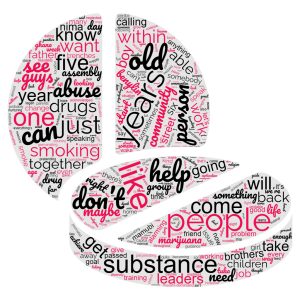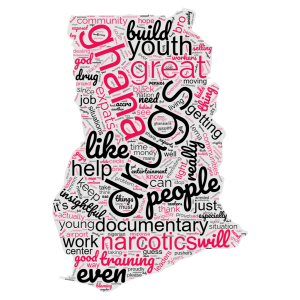The power of documentaries
People and Places Africa made a documentary about the substance use among the youth in Nima, Accra. This documentary further zooms in on why young people use substances according to community leaders and the young people themselves. It further explores how action can be taken to address the problem. But what image does the documentary paint of young people using drugs and how is this recieved by the audience? In this assignment, I will do a discourse analysis on the documentary and the comments on the documentary which can be found on Youtube.

Wordcloud of the documentary ‘Is Ghana’s drug situation becoming a problem?’, made with Wordclouds.com
The message
To start, we look at the message of the documentary. In my opinion, the focus of this documentary is to inform people that there is a problem in Nima and that it is time to take action. The presenter says in the end and in the beginning of the documentary that the leaders should work together to reduce drug abuse among the youth within a certain time frame. From morphology in the documentary, it is noticeable that different terms for drugs are used and different types of drugs are named, but also that words related to providing help, such as ‘need’ and ‘help’, come up. Problem language also occurs, such as ‘alarming’ and ‘problem’. This language ensures that the message comes across more clearly. For example, using “alarming” gives people the idea that action must be taken now to avoid a worse situation.
The documentary includes several community leaders and the youth themselves. They also have their own message that they want to convey to the audience. The youth talk about the reasons for the reasons for their use, and some talk about how they do want to stop using but feel somewhat abandoned by the community. They do have dreams for the future, such as one of the youth who talks about wanting to become a nurse. I think the message from the youth is that they need help and want to see change themselves. The documentary does play a role in how the youth convey their message. Through the way of framing and questions asked, the documentary gives a direction to the young people’s story. It appears to me that the youth are portrayed as victims of a larger problem, namely unemployment, an unstable economic situation in the country and dysfunctional family systems.
The leaders talk about the various causes of drug use, such as becoming parents early, not enough facilities in the community and not enough job opportunities. They also talk about how they think youth drug use can reduce or stop. One of the leaders explains that youth are welcome to ask for help. The leaders’ message also seems to be that young people should be helped and that young people should know that they can ask for help.
“They see you smoke, they think you dumb, no you ain’t dumb”
– People and Places Africa, 2022
The medium
The medium in this case is a documentary on Youtube. This documentary has been watched 12,000 times and has 100 comments on it. The choice of a documentary on Youtube ensures that anyone who has internet at their disposal could theoretically watch this documentary. In Ghana, 7.9 million people are illiterate (Ghana Statistical Service, 2022). By choosing a documentary to raise an issue, it ensures that people who are illiterate can also follow the story. These people are not expected to leave comments under the documentary which causes their reaction to be unanalyzable.
Among other things, the Internet allows for more diversity in society by allowing multiple opinions to be heard and topics to be brought up but, on the other hand, also creates an overload of information (Neuberger & Logis, 2010;34-35). The documentary is an example of this. Several responses say it is good that attention is being paid to this and would like to see more on this topic and there is room to respond to each other’s opinions via Youtube. This shows that the media does not have total power, but it is the playing field in which it decides where the power is (Castells, 2007; p242).
The medium has a lot of power because this medium determines the story being told. The young people are depicted on this documentary as young people who started using drugs due to a confluence of sad circumstances, such as the death of parents at an early age. In doing so, it also shows how the young people feel and what their dreams are for the future. The young people are portrayed full in the picture while it looks like they have been using. On the one hand, this makes the story come across more strongly to the audience but, on the other hand, it also begs the question of how ethical this is. In my opinion, a young person who has used drugs cannot give clear consent, but it is also a question whether anyone gave consent when they were sober.
“Kindly share your contact with me, I think we can work on some things to help the youth. Waiting for your response”
– A comment on the documentary ‘Is Ghana’s drug situation becoming a problem?’, 2023

Wordcloud of the comments on the documentary ‘Is Ghana’s drug situation becoming a problem?’, made with Wordclouds.com
The response
The next question is how the audience received the documentary. Looking at the morphology of the comments, I think there are some important words to be found, such as insightful, interesting and great that emphasize that the documentary is positively received. It is also noticeable that several words seem to be about work such as work, job and training. The comments are mostly about the content of the documentary but also mention that the documentary is well filmed. Through close reading of the comments, it becomes clear that these words indicate what the audience seems to wish for the youth or that work and training are needed to keep the youth off drugs.
Furthermore, the response that is in the quote also stands out in this text. In it, someone who has seen the documentary asks to get in touch to help youth together. This is a good example of Manuel Castells’ network society theory (2023). This theory explains that the social structure of our time is the “Information Age” in which the global structure is characterized by extreme diversity of culture and institutions. Not everyone is included in this structure but everyone is affected in some way by the dynamics of this Information Age, especially in part because of social networks on the Internet. These social networks have the power to self-select what is important to share through self-communication, unlike, for example, traditional media such as the news (2023:941-943). This documentary seems to call to action for some people who watched this. This shows that technology is important because through Youtube the documentary gets to people, but the social aspect is equally important because the people who watch the documentary ultimately decide whether to do something with it or not. So the power lies not only with the documentary makers and their way of shaping the situation, but also with the audience who decides whether to take action.
So, how are the young people using drugs portrayed in this documentary, and how is this received by the audience? To answer this question, I will split the question in half and begin with how the youths are portrayed. Visually, the youths are portrayed as having plausibly used drugs. On the one hand, this is an ethical issue, but on the other hand, it is strong in conveying the message of the documentary. When zooming in on the message of the youth, there is hope, but the youth seem to feel abandoned by, mainly the community leaders and additionally show insecurity, telling them that they think people think they are dumb, for example. In my opinion, the youth are portrayed as victims of large socio-economic problems. In the comments it is also noticeable that there are certainly some people who find it “sad” and think that help is needed for these young people. A few write about that the young people themselves should take action by going to work, but most seem to feel sorry for the young people. This shows that the message gets across to the audience, but also this documentary shows the power of the network society where people take action to help each other.
References:
Castells, Manuel. (2007). Communication, Power and Counter-Power in the Network Society. International Journal of Communication 1.
Castells, M. (2023). The Network Society Revisited. Sage Publications, 67(7), 941–943. https://doi.org/10.1177/00027642221092803
Ghana Statistical Service (2022). About 8 million persons in Ghana are illiterate. Retrieved December 21 2023, from https://www.statsghana.gov.gh/infobankdetails.php?infobank=MjI5NjA1MzU3Mi43NTU1/infodesk/249ssp0p7r
Neuberger C., Logis F. (2010). Die Bedeutung des Internets im Rahmen der Vielfaltssicherung. Gutachten für die Kommission zur Ermittlung der Konzentration im Medienbereich (KEK). [The importance of the Internet in the context of ensuring diversity. Report for the investigation Commission on concentration in the media sector (KEK)]. Berlin, Germany: Vistas.
Leave a comment
You must be logged in to post a comment.